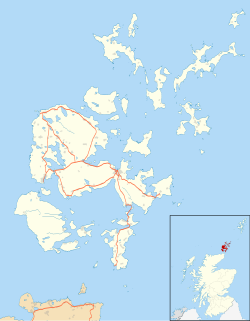| RNAS Hatston (HMS Sparrowhawk) | |||||||||||||
|---|---|---|---|---|---|---|---|---|---|---|---|---|---|
| Kirkwall, on the Mainland of Orkney in Scotland | |||||||||||||
 Fairey Swordfish taxi along the tarmac to take off for an exercise with dummy torpedoes from HMS Sparrowhawk, Royal Naval Air Station, Hatston | |||||||||||||
 HMS Sparrowhawk | |||||||||||||
| Site information | |||||||||||||
| Type | Naval Air Station | ||||||||||||
| Code | H | ||||||||||||
| Owner | Admiralty | ||||||||||||
| Operator | |||||||||||||
| Controlled by | Fleet Air Arm | ||||||||||||
| Condition | Disused | ||||||||||||
| Location | |||||||||||||
| Coordinates | 58°59′39″N002°58′35″W / 58.99417°N 2.97639°W | ||||||||||||
| Grid reference | HY435125 | ||||||||||||
| Site history | |||||||||||||
| Built | 1934 | ||||||||||||
| In use | October 1939 - 1948 | ||||||||||||
| Fate | Closed | ||||||||||||
| Battles/wars | European theatre of World War II | ||||||||||||
| Garrison information | |||||||||||||
| Garrison | Fleet Air Arm | ||||||||||||
| Occupants |
| ||||||||||||
| Airfield information | |||||||||||||
| Elevation | 7 metres (23 ft) AMSL | ||||||||||||
| |||||||||||||
Royal Naval Air Station Hatston (RNAS Hatston, also called HMS Sparrowhawk), was a military airfield located one mile to the north west of Kirkwall, on the island of Mainland, Orkney, Scotland, built as a Royal Naval Air Station. It was located near the strategically vital naval base of Scapa Flow, which for most of the twentieth century formed the main base of the ships of the Home Fleet. The airbase was designed to provide accommodation for disembarked Front-Line squadrons and accommodation for disembarked Ship's Flight Aircraft and was home to the Home Fleet Fleet Requirements Unit, 771 Naval Air Squadron.
Contents
- History
- Second World War (1939–1945)
- Units
- Post Royal Navy and current use
- See also
- References
- Citations
- Bibliography
- External links
The airbase was situated near two notable landmarks, it was located next to the town and port of Kirkwall, with Scapa Flow 2.5 miles (4 km) south. The airfield was sited on the south bank of the Bay of Kirkwall, 1 mile (2 km) north east of the town of Kirkwall, and the road from Kirkwall to Finstown forms the southern boundary of the airfield. [1]
It was purpose built by the Admiralty and commissioned on 2 October 1939 as HMS Sparrowhawk, the airbase remained operational for almost six years, before It was ‘paid off’ on 1 August 1945. It immediately re-commissioned on the same day as HMS Tern II. Six weeks later it decommissioned for a second time, on 15 September and the airbase was reduced to care and maintenance. [1]


